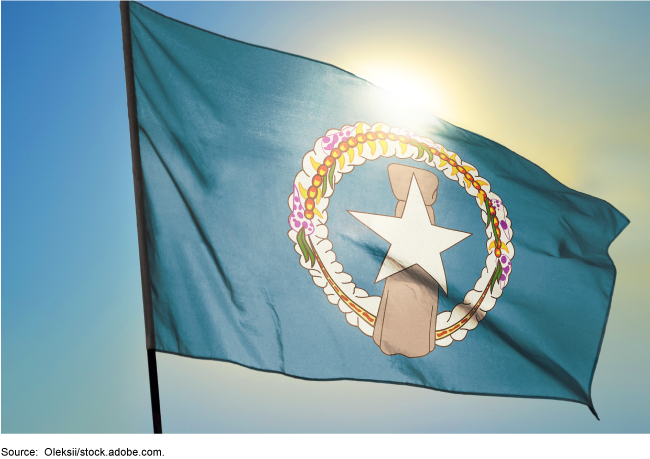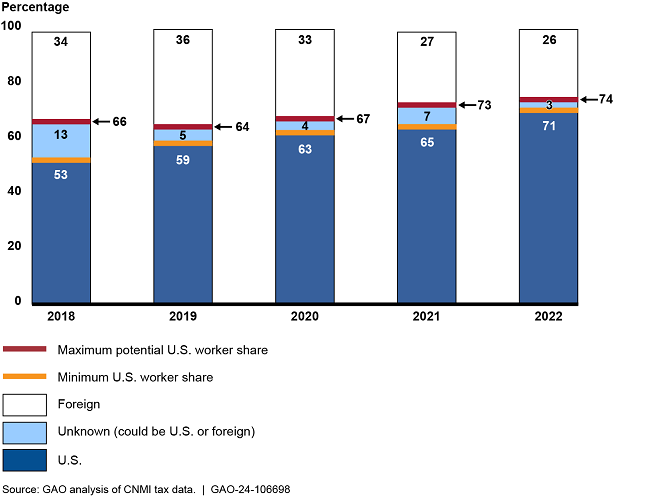Commonwealth of the Northern Mariana Islands: Greater Transparency Could Improve Worker Ratio Reports
Fast Facts
The Commonwealth of the Northern Mariana Islands is a U.S. territory in the Pacific. In this Q&A report, we review its worker data and reporting from 2018-2022.
U.S. workers made up at least half of employed workers
U.S. workers comprised a greater portion of employed workers in 2022 than in 2018
During this time, the economy declined due to a typhoon, COVID-19, and the closure of a major employer
We recommended ways to improve the territory's annual worker ratio report, such as by adding key information about how the government categorizes workers as U.S. or foreign, to make the report easier to replicate and interpret.

Highlights
What GAO Found
U.S. workers made up at least half of employed workers in the Commonwealth of the Northern Mariana Islands (CNMI) between 2018 and 2022, according to GAO's analysis of CNMI tax data. When comparing 2018 to 2022, GAO found the U.S. portion of CNMI workers increased and the foreign portion decreased. In addition to categorizing U.S. and foreign workers using the CNMI tax data, GAO categorized workers as "unknown" when the data were insufficient to place them in the other two categories. Due to this unknown portion, the precise ratio of U.S. to foreign workers for each year is uncertain. The figure below illustrates the minimum share U.S. workers represented each year, as well as the degree to which that share might increase depending on whether unknown workers were U.S. or foreign.
U.S. and Foreign Workers in the Commonwealth of the Northern Mariana Islands (CNMI), Calendar Years 2018–2022

Note: GAO’s categorization of these workers is based solely on CNMI’s tax data and is not a determination based on records underlying the data of whether any individual meets the definition of U.S. worker under the Northern Mariana Islands U.S. Workforce Act of 2018. Percentages shown for 2021 do not sum to 73 and 100 due to rounding. For more details, see section related to fig. 1 in GAO-24-106698.
The Northern Mariana Islands U.S. Workforce Act of 2018 (the Act) requires the Governor of CNMI to report annually on the ratio of U.S. to foreign workers. To create these reports, the CNMI government uses employers' tax data. However, it has reported that these data include a relatively high share of workers with unknown visa types—from 13 to 33 percent in the 2018 to 2021 reports, making the precise ratio of U.S. to foreign workers uncertain. CNMI has recently taken steps to improve its data analysis process, reducing the unknown portion of workers to 4 percent in the 2022 data.
The CNMI government has taken some steps to communicate the analytical approach it uses to create its annual worker ratio report. For example, it uses the report and a Standard Operating Procedure to communicate some of its analytical approach. However, these documents do not include key information such as the approach CNMI uses to categorize unknown workers as U.S. or foreign, as well as the implications of the unknown portion for the ratio. Key elements of economic analysis call for transparency of an analytical approach to allow the public to assess its structure and to understand how much of its result hinges on the specific choices made by the authors.
Improved transparency of the approach could benefit CNMI and other stakeholders. Specifically, greater transparency would enable CNMI officials to consistently replicate recent improvements to the annual worker ratio reports in the future. It would also help CNMI and stakeholders determine worker trends over time and assess whether CNMI's efforts to achieve one of the Act's goals—increasing the percentage of U.S. workers in the CNMI workforce—have been successful.
The Office of Insular Affairs within Interior promotes the coordination of federal policy for CNMI and provides discretionary financial and technical assistance to CNMI. Interior officials also said they work with CNMI to identify the needs for future grants and coordinate that work with other agencies as appropriate.
Why GAO Did This Study
CNMI's economy has historically relied on foreign workers, who made up more than half of its workers for the decade before the passage of the Consolidated Natural Resources Act of 2008 (CNRA). Under the CNRA, the Department of Homeland Security established a temporary foreign worker permit program for the CNMI called the CNMI-Only Transitional Worker (CW-1) program. The 2018 Act extended the CW-1 program through December 31, 2029, and sought, in part, to increase the percentage of U.S. workers in the total CNMI workforce while maintaining the minimum number of workers who are not U.S. workers to meet the changing demands of CNMI's economy. The Act calls for various reports on CNMI's progress toward this goal, including an annual report by CNMI's Governor identifying the ratio between U.S. workers and foreign workers in CNMI's workforce.
The Act includes a provision for GAO to report every 2 years on the ratio between U.S. and foreign workers in CNMI's workforce in each of the previous 5 calendar years. This is GAO's third report in response to the provision. GAO analyzed CNMI government and U.S. agency data and reports, reviewed prior GAO reports, and interviewed and corresponded with officials from CNMI's government and the U.S. Departments of Homeland Security, the Interior, and Labor.
Recommendations
GAO is recommending that Interior work with the CNMI government and, as appropriate, other U.S. agencies to determine what steps can be taken to improve transparency of the analytical approach CNMI uses to create its annual worker ratio report. Interior concurred with GAO's recommendation.
Recommendations for Executive Action
| Agency Affected | Recommendation | Status |
|---|---|---|
| Department of the Interior | The Secretary of the Interior should ensure that the Assistant Secretary for Insular and International Affairs works with the CNMI government and, as appropriate, other U.S. agencies to determine what steps can be taken to improve transparency of the analytical approach CNMI uses to create its annual worker ratio report. Such steps could include communicating in greater detail, through CNMI's Standard Operating Procedure document and worker ratio report, the analytical approach CNMI took to categorize unknown workers as either U.S. or foreign, as well as the implications of the unknown portion for the ratio. |
When we confirm what actions the agency has taken in response to this recommendation, we will provide updated information.
|
